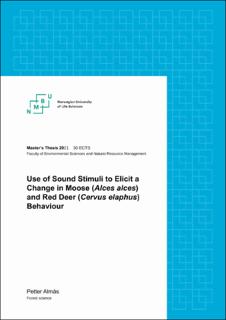| dc.contributor.advisor | Steen, Ronny | |
| dc.contributor.advisor | Mathisen, Karen Marie | |
| dc.contributor.author | Almås, Petter | |
| dc.coverage.spatial | Norway | en_US |
| dc.date.accessioned | 2021-08-30T11:35:36Z | |
| dc.date.available | 2021-08-30T11:35:36Z | |
| dc.date.issued | 2021 | |
| dc.identifier.uri | https://hdl.handle.net/11250/2771764 | |
| dc.description.abstract | Over the years, a lot of different actions have been tested in order to prevent road and railway collisions with cervids. Amongst them, actions aiming to change animal behaviour. The aim of such actions has been to elicit a change in behaviour and to make the animals leave the area preliminary to prevent collisions. Cervids do naturally show anti-predator behaviour when something they connect with danger occurs. In this thesis, I wanted to study how moose (Alces alces) and red deer (Cervus elaphus) changed their behaviour when they were exposed to natural harmless sounds and sounds associated with predators. This was studied by exposing them to different sound stimuli through a motion-activated scare system (MASS) at winter feeding stations in South-Eastern Norway. The experiment was monitored with video cameras.
I investigated how different sound stimuli affected the proportion of the animals leaving the site, and the proportion of time they used for browsing and being vigilant. I compared the behaviour responses to the different sounds with normal behaviour at feeding stations. I found that the sound of a barking dog and a human voice elicited a change in behaviour for moose that in most cases made them leave the site. The more harmless sounds did not lead to such strong reactions. For the red deer the results were markedly weaker, and only the human stimulus lead to a significantly higher proportion of the animals leaving the site, compared with the normal behaviour. For both moose and red deer there were signs of habituation to the sounds within a relatively short time, though, red deer showed faster habituation than moose. The results confirm that the sound of a dog and a human can be efficient for eliciting a change in behaviour for moose, and thus be used in the further development of a technical system to prevent accidents with moose at the railway. For red deer other stimuli might be more efficient, due to the low response to the stimuli tested here. | en_US |
| dc.description.abstract | Over tid har mange ulike tiltak mot hjorteviltpåkjørsler blitt undersøkt. Blant dem, tiltak som har som mål å endre atferden til dyrene. Målet med slike tiltak er å fremkalle en endring i atferd for å få dyrene til å midlertidig forlate et område. Hjortevilt viser naturlig en anti-predator atferd når de utsettes for noe som de forbinder med predatorer. I denne studien ønsket jeg å studere hvordan elg og hjort endrer sin atferd når de eksponeres for naturlige harmløse lyder og lyder som de assosierer med predatorer. Dette ble studert ved å eksponere dem for ulike lydstimuli gjennom et «bevegelsesaktivert skremme-system» (MASS) på fôringsstasjoner i Sørøst-Norge. Eksperimentet ble overvåket med viltkameraer.
Jeg undersøkte hvordan ulike lydstimuli påvirket andelen dyr som forlater fôringsstasjonen samt andelen av tiden de brukte til henholdsvis beiting og årvåkenhet. Jeg sammenliknet atferdsresponsen til de ulike lydstimuliene med dyrenes normalatferd på fôringsstasjonene. Jeg fant at lyden av losende hund og menneskestemme fremkalte en endring i atferd for elg som gjorde at de forlot fôringsstasjonen. De mer harmløse lydene førte ikke til en like sterk reaksjon. For hjort var resultatene markant svakere, og det var bare lyden av menneskestemme som førte til at en signifikant høyere andel av dyrene forlot fôringsstasjonen sammenliknet med normalatferden. For både elg og hjort var det tegn til habituering/tilvenning til lydene innen kort tid. Hjorten viste en raskere tilvenning enn elgen. Resultatene bekrefter at lyder som elgen kan assosiere med en predator kan være effektive for å fremkalle en endring i atferd, og dermed være interessant for den videre utviklingen av et teknisk system for å forebygge hjorteviltpåkjørsler på jernbanen. For hjort kan det i henhold til resultatene være at andre lydstimuli har en større effekt enn lydene testet i denne studien. | en_US |
| dc.language.iso | eng | en_US |
| dc.publisher | Norwegian University of Life Sciences, Ås | en_US |
| dc.rights | Attribution-NonCommercial-NoDerivatives 4.0 Internasjonal | * |
| dc.rights.uri | http://creativecommons.org/licenses/by-nc-nd/4.0/deed.no | * |
| dc.title | Use of sound stimuli to elicit a change in moose (Alces alces) and red deer (Cervus elaphus) behaviour | en_US |
| dc.type | Master thesis | en_US |
| dc.subject.nsi | VDP::Matematikk og Naturvitenskap: 400::Zoologiske og botaniske fag: 480::Zoofysiologi og komparativ fysiologi: 483 | en_US |
| dc.description.localcode | M-SF | en_US |

